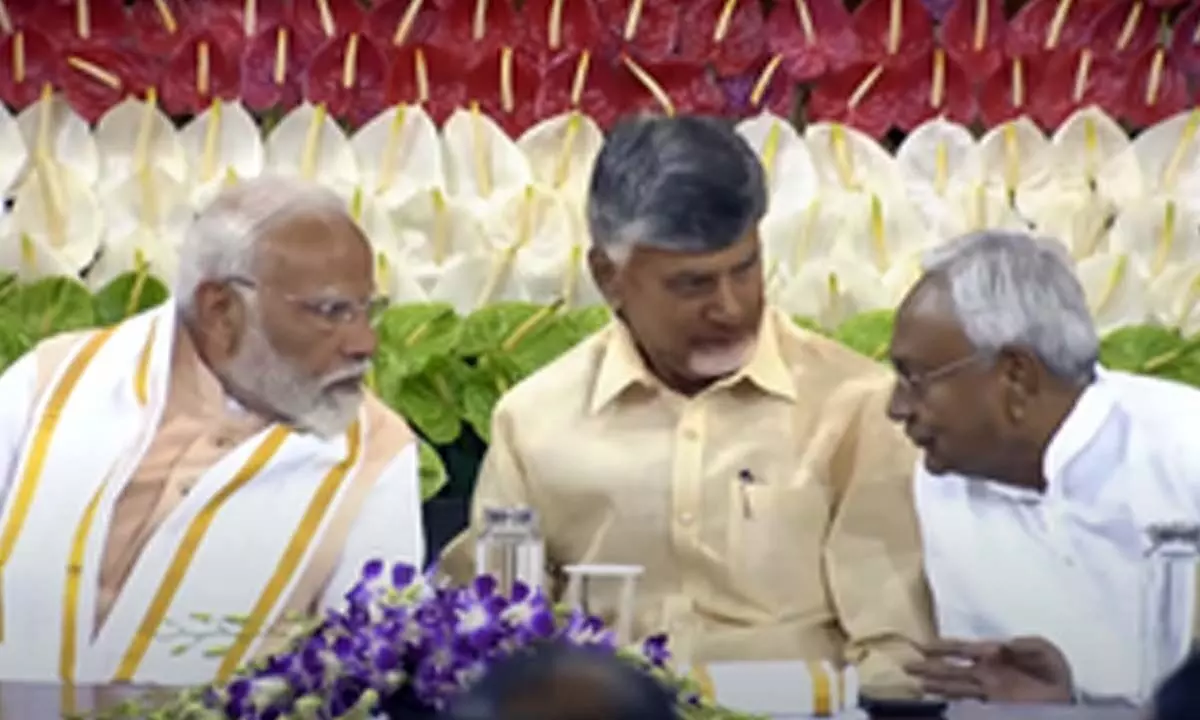Live
- Over 7,600 Syrians return from Turkiye in five days after Assad's downfall: minister
- Delhi BJP leaders stay overnight in 1,194 slum clusters
- Keerthy Suresh and Anthony Thattil Tie the Knot in a Christian Ceremony
- AAP, BJP making false promises to slum dwellers for votes: Delhi Congress
- 'Vere Level Office' Review: A Refreshing Take on Corporate Life with Humor and Heart
- Libya's oil company declares force majeure at key refinery following clashes
- Illegal Rohingyas: BJP seeks Assembly session to implement NRC in Delhi
- Philippines orders full evacuation amid possible volcanic re-eruption
- Government Prioritizes Welfare of the Poor, says Dola Sri Bala Veeranjaneyaswamy
- Two Russian oil tankers with 29 on board damaged due to bad weather
Just In

On Friday noon, Prime Minister Narendra Modi walked inside the Central Hall of the old Parliament House, amid cheers, clapping and thumping of desks, straight to a decorated corner near the podium to bow before the original copy of India’s Constitution and lift it for a few moments to touch it to his forehead.
New Delhi: On Friday noon, Prime Minister Narendra Modi walked inside the Central Hall of the old Parliament House, amid cheers, clapping and thumping of desks, straight to a decorated corner near the podium to bow before the original copy of India’s Constitution and lift it for a few moments to touch it to his forehead.
The symbolism or the messaging of it couldn’t have been missed – for PM Modi, it was "Samvidhan Sarvopari (Constitution supreme)", particularly when his political rivals in the run-up to the elections tried to weave a rather fictional narrative that if re-elected, the Modi government would change the constitution and scrap reservation for marginalised classes.
The significance of the venue, chosen for the special occasion – for the election of PM Modi as leader of the 293-member strong pre-poll alliance NDA, their unanimous choice to be the Prime Minister for the third consecutive time – as mentioned by Home Minister Amit Shah was noteworthy.
The Constituent Assembly sat here to draft the Constitution. Also, it sent another message that the old Parliament House was not abandoned by the ruling dispensation, and its historicity and dignity shall be maintained.
The nation, which was hooked to the live proceedings of the occasion, was keenly watching to see whether there was a sense of unity and purpose among the PM Modi-led NDA. It was all positive – their body language, the cordiality, the bonhomie, the speeches made by the top leaders of the ruling alliance on how they worked together to reach this momentous occasion, creating history after 62 years when an incumbent Prime Minister for two terms is all set to take the oath of office for the third straight term and what the road ahead is.
It should be noted that the friendliness, the connect seen on the podium between Prime Minister Modi and two NDA partners, N. Chandrababu Naidu, Chief Minister-designate of Andhra Pradesh and TDP chief, and Nitish Kumar, the Bihar Chief Minister and JD-U chief, was not new-found and certainly not for the camera. They share a long-standing relationship, over two and a half decades old. There had been some hiccups but now they are back in one fold, back as colleagues, friends and peers, as they say, all's well that ends well.
The mutual appreciation and vision for the future, not just for the next five years but as both Naidu and Nitish said, beyond 2029 flowed freely. PM Modi asserted that in the next 10 years, the NDA government will write fresh chapters of good governance.
PM Modi made particular mention of how NDA had remained intact for the last two and half decades. It had seen many seasons including three full terms in power at the centre and was now poised to take yet another historic leap forward.
Nitish Kumar, then as leader of the Samata Party, was part of the original NDA coalition that was built by Atal Bihari Vajpayee, L.K. Advani, George Fernandes of Samata Party, Parkash Singh Badal of Akali Dal, and Balasaheb Thackeray of Shiv Sena in 1998. Modi was then the youngest national General Secretary of the BJP and had a backroom role to play in stitching the alliance.
Chandrababu Naidu became part of the NDA in 1999. He remained Chief Minister of Andhra Pradesh and his party nominee G.M.C. Balayogi was named as Speaker of Lok Sabha and the TDP extended outside support to the Vajpayee government. In 2001 when Modi became Chief Minister of Gujarat, Nitish Kumar was Railway Minister and they worked closely on various projects. As chief ministers of two NDA-ruled states, Modi and Naidu shared another kind of equation.
Over two decades later, they have come to share yet another kind of close equation. PM Modi said: "NDA stands stronger and more united than ever before." The NDA, according to him, was an alliance committed to the 'Nation First' philosophy.

© 2024 Hyderabad Media House Limited/The Hans India. All rights reserved. Powered by hocalwire.com






